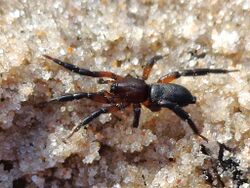Biology:Gnaphosoidea
| Gnaphosoidea | |
|---|---|

| |
| Gnaphosa bicolor | |
| Scientific classification | |
| Domain: | Eukaryota |
| Kingdom: | Animalia |
| Phylum: | Arthropoda |
| Subphylum: | Chelicerata |
| Class: | Arachnida |
| Order: | Araneae |
| Infraorder: | Araneomorphae |
| Clade: | Entelegynae |
| Clade: | Dionycha |
| Superfamily: | Gnaphosoidea Simon, 1893[1] |
| Families | |
|
See text | |
The Gnaphosoidea or gnaphosoids are a superfamily of araneomorph spiders with seven families. A 2014 study did not find the group to be monophyletic.
Phylogeny
Gnaphosoidea has been circumscribed to contain the following families:[1]
Gnaphosoidea has been placed in the Dionycha clade, itself part of the RTA clade:[2]
| RTA clade |
| ||||||||||||||||||
The Prodidomidae, Lamponidae and Gnaphosidae have been considered "higher gnaphosoids", sharing anterior lateral spinnerets consisting of only a single "joint" (article); the "lower gnaphosoids" (Ammoxenidae, Cithaeronidae, Gallieniellidae and Trochanteriidae) retain a distal article that is represented by an entire ring of hardened (sclerotized) cuticle.[3] (Earlier the Lamponidae were grouped with the "lower gnaphosoids", having spinnerets of an intermediate kind.[4]) One hypothesis for the internal phylogeny of the gnaphosoids, defined in this way, is:[2]
| Gnaphosoidea |
| ||||||||||||||||||||||||||||||||||||
A 2014 study of dionychan spiders did not recover Gnaphosoidea as a monophyletic group, instead finding "gnaphosoid" families other than Gnaphosidae and Prodidomidae to be part of a larger clade, mixed in with three other dionychan families, Liocranidae, Trachelidae and Phrurolithidae. Forcing Gnaphosoidea to be monophyletic produced results described as "quite suboptimal".[5]
References
- ↑ 1.0 1.1 Dunlop, Jason A.; Penney, David (2011). "Order Araneae Clerck, 1757". in Zhang, Z.-Q.. Animal biodiversity: An outline of higher-level classification and survey of taxonomic richness. Zootaxa. Auckland, New Zealand: Magnolia Press. ISBN 978-1-86977-850-7. http://mapress.com/zootaxa/2011/f/zt03148p153.pdf. Retrieved 2015-10-31.
- ↑ 2.0 2.1 Nentwig, Wolfgang, ed. (2013), "Appendix : Spider Phylogeny", Spider Ecophysiology, Springer, ISBN 978-3-642-33988-2, https://link.springer.com/content/pdf/bbm%3A978-3-642-33989-9%2F1.pdf, retrieved 2015-11-03
- ↑ Platnick, Norman I.; Baehr, Barbara C. (2006). "A revision of the Australasian ground spiders of the family Prodidomidae (Araneae, Gnaphosoidea)". Bulletin of the American Museum of Natural History 298 (298): 1–287. doi:10.1206/0003-0090(2006)298[1:AROTAG2.0.CO;2]. http://digitallibrary.amnh.org/dspace/bitstream/2246/5788/1/B298a01.pdf.
- ↑ Platnick, N.I. (2002), "A revision of the Australasian ground spiders of the families Ammoxenidae, Cithaeronidae, Gallieniellidae, and Trochanteriidae (Araneae: Gnaphosoidea)", Bulletin of the American Museum of Natural History 271 (271): 1–244, doi:10.1206/0003-0090(2002)271<0001:AROTAG>2.0.CO;2, https://www.researchgate.net/publication/232680058, retrieved 2015-11-20
- ↑ Ramírez, M. (2014). "The morphology and phylogeny of Dionychan spiders (Araneae: Araneomorphae)". Bulletin of the American Museum of Natural History 390 (390): 1–374. doi:10.1206/821.1. pp. 323–327.
Wikidata ☰ Q54895 entry
 |

